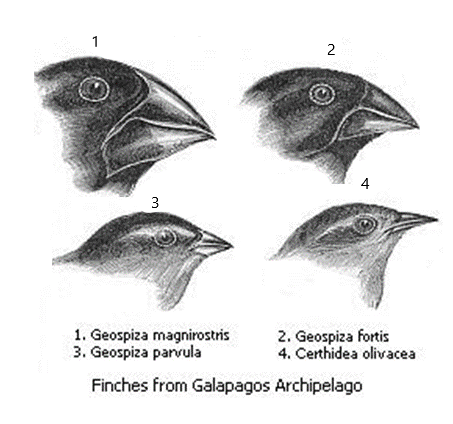
In the Galapagos Islands, Darwin observed variations in structure in
A. Elephants
B. Giraffes
C. Rats
D. Finch birds
Answer
489.6k+ views
1 likes
Hint:Charles Darwin in the year 1835 went on a voyage to the Caribbean to perform geological research of the islands. It was in one of the islands of the Galapagos did Charles Darwin identify a stark evolutionary difference in finches and made detailed notes from which he identified a divergence in the structure of the beaks of the birds based on the islands the birds came from.
Complete step by step answer:
Charles Darwin set voyage on the HMS Beagle in 1835 to the islands of the south pacific near south America with an initial intention to conduct geological survey and research of the various islands. Upon reaching the islands, however, Charles Darwin’s interest laid elsewhere.
During his research, he was more curious about the plant and animal species that inhabited the islands. The crew of the HMS Beagle would often catch the San Cristobal giant tortoises for food but Darwin would be more interested in the shell shape of the tortoises. He proposed that he could identify which specific island the tortoise was from based on the shell structures as tortoises diverged into different islands and evolved different structures and shapes.
He also identified the same phenomenon on the finches which were small birds. He observed that finches on the different islands had different beak structures. This was due to the different forms of food available to the birds at different islands and the finches evolved different structures to feed on different food sources.
It was only after Charles Darwin’s research were theories of evolution such as adaptive radiation and divergent evolution were formalized.

Therefore, the correct answer is option D.
Note:One of Darwin's most important findings was the adaptive radiation of the finches in the Galapagos and subsequently, the finches from the islands were then forth known as Darwin’s finches. His research set the foundation for several theories but mainly for the acceptance of the concept of divergent evolution. Jean Lamark is also well known for his contributions to the field of evolutionary science but his research was limited to the inheritance of acquired traits and was concerned with giraffes.
Complete step by step answer:
Charles Darwin set voyage on the HMS Beagle in 1835 to the islands of the south pacific near south America with an initial intention to conduct geological survey and research of the various islands. Upon reaching the islands, however, Charles Darwin’s interest laid elsewhere.
During his research, he was more curious about the plant and animal species that inhabited the islands. The crew of the HMS Beagle would often catch the San Cristobal giant tortoises for food but Darwin would be more interested in the shell shape of the tortoises. He proposed that he could identify which specific island the tortoise was from based on the shell structures as tortoises diverged into different islands and evolved different structures and shapes.
He also identified the same phenomenon on the finches which were small birds. He observed that finches on the different islands had different beak structures. This was due to the different forms of food available to the birds at different islands and the finches evolved different structures to feed on different food sources.
It was only after Charles Darwin’s research were theories of evolution such as adaptive radiation and divergent evolution were formalized.

Therefore, the correct answer is option D.
Note:One of Darwin's most important findings was the adaptive radiation of the finches in the Galapagos and subsequently, the finches from the islands were then forth known as Darwin’s finches. His research set the foundation for several theories but mainly for the acceptance of the concept of divergent evolution. Jean Lamark is also well known for his contributions to the field of evolutionary science but his research was limited to the inheritance of acquired traits and was concerned with giraffes.
Recently Updated Pages
Master Class 12 Economics: Engaging Questions & Answers for Success

Master Class 12 Maths: Engaging Questions & Answers for Success

Master Class 12 Biology: Engaging Questions & Answers for Success

Master Class 12 Physics: Engaging Questions & Answers for Success

Master Class 12 Business Studies: Engaging Questions & Answers for Success

Master Class 12 English: Engaging Questions & Answers for Success

Trending doubts
Which are the Top 10 Largest Countries of the World?

a Tabulate the differences in the characteristics of class 12 chemistry CBSE

Why is the cell called the structural and functional class 12 biology CBSE

Differentiate between homogeneous and heterogeneous class 12 chemistry CBSE

Derive an expression for electric potential at point class 12 physics CBSE

When was the first election held in India a 194748 class 12 sst CBSE




